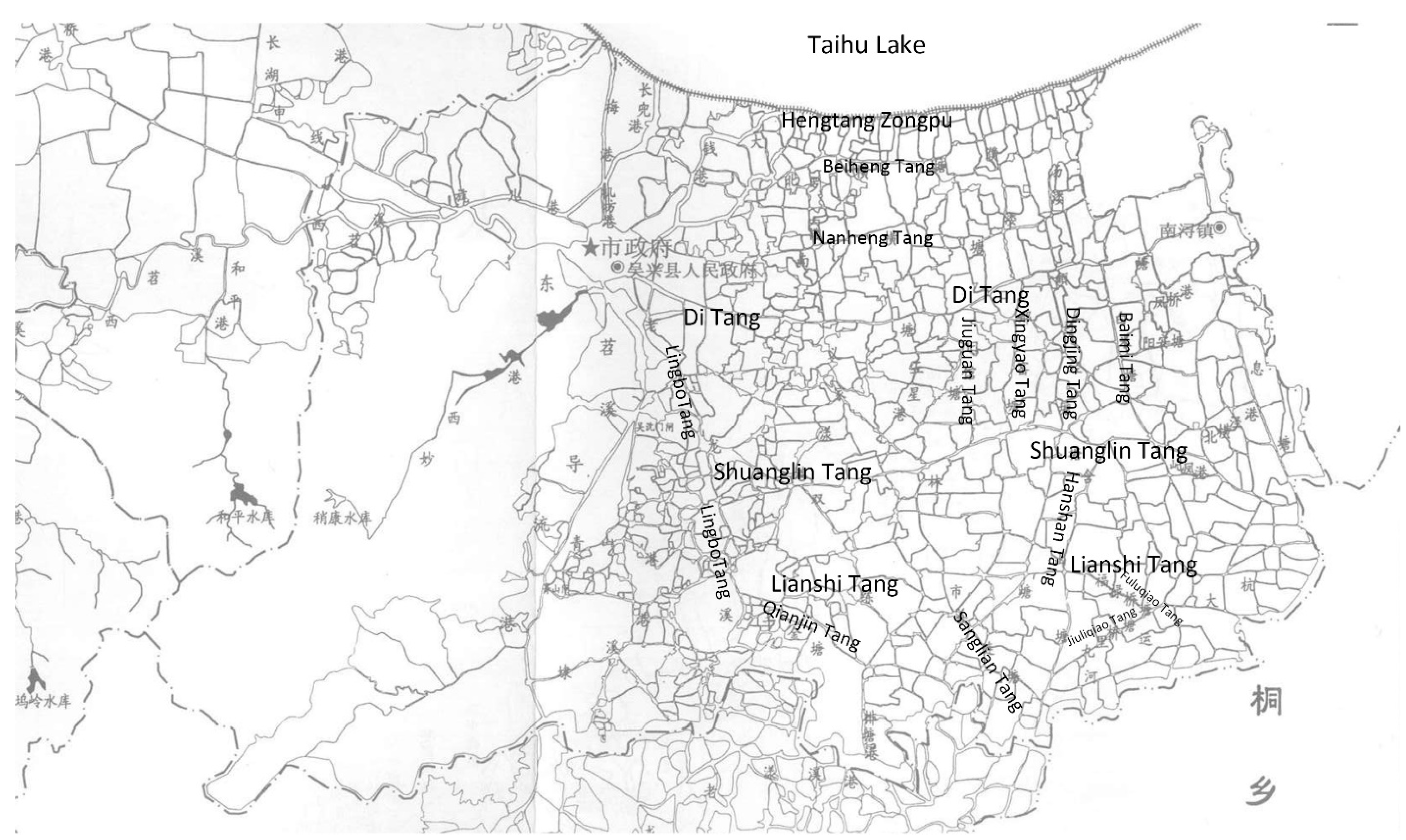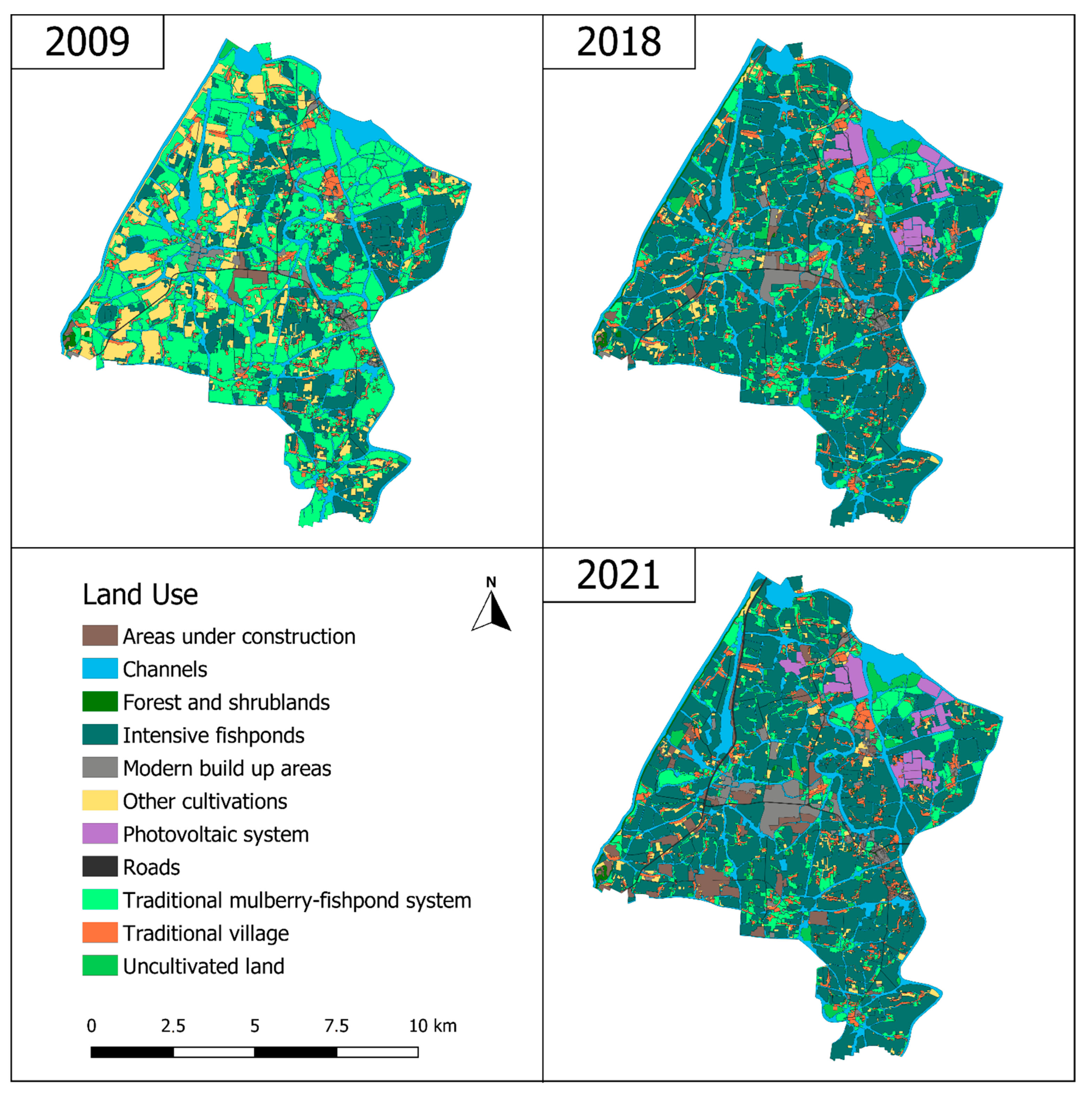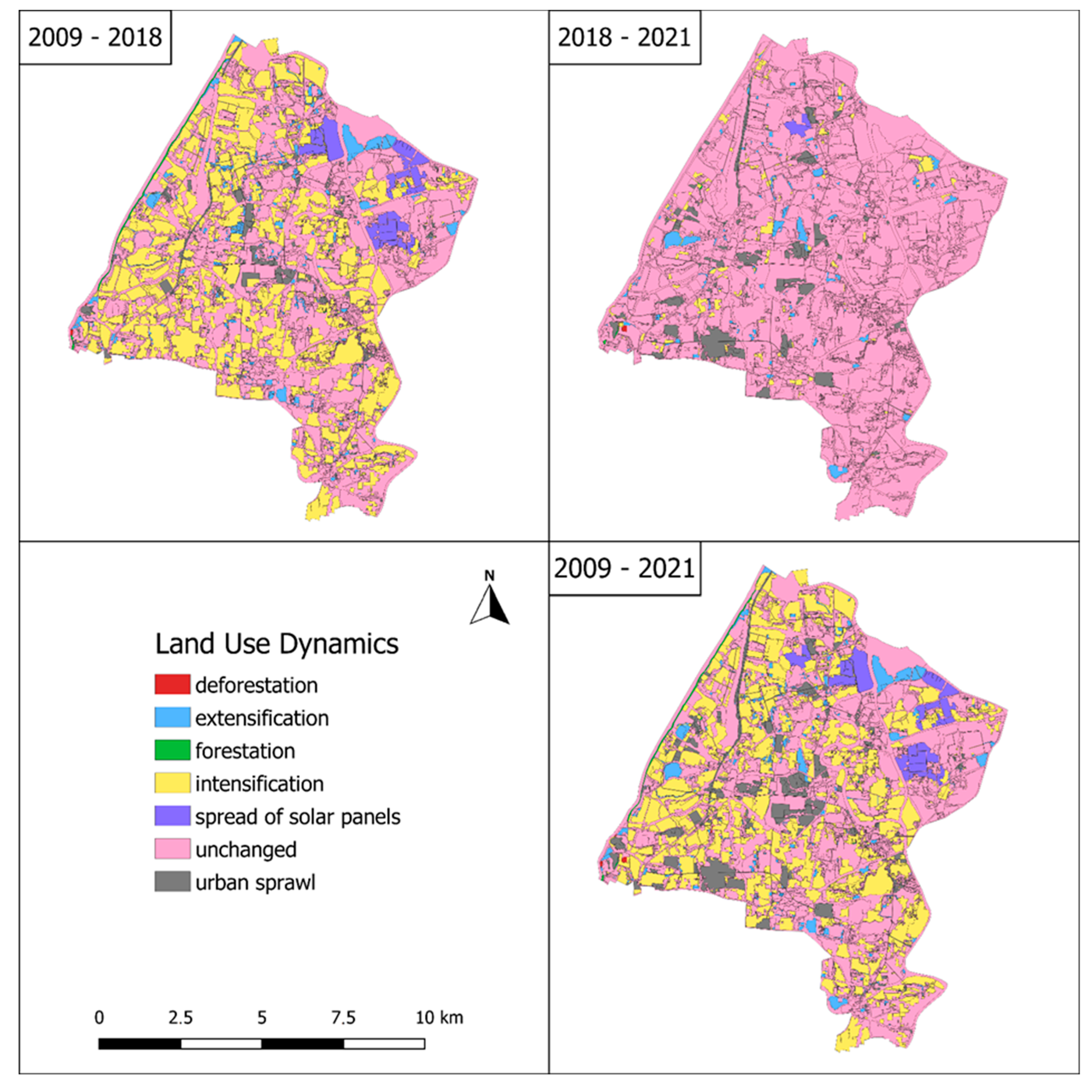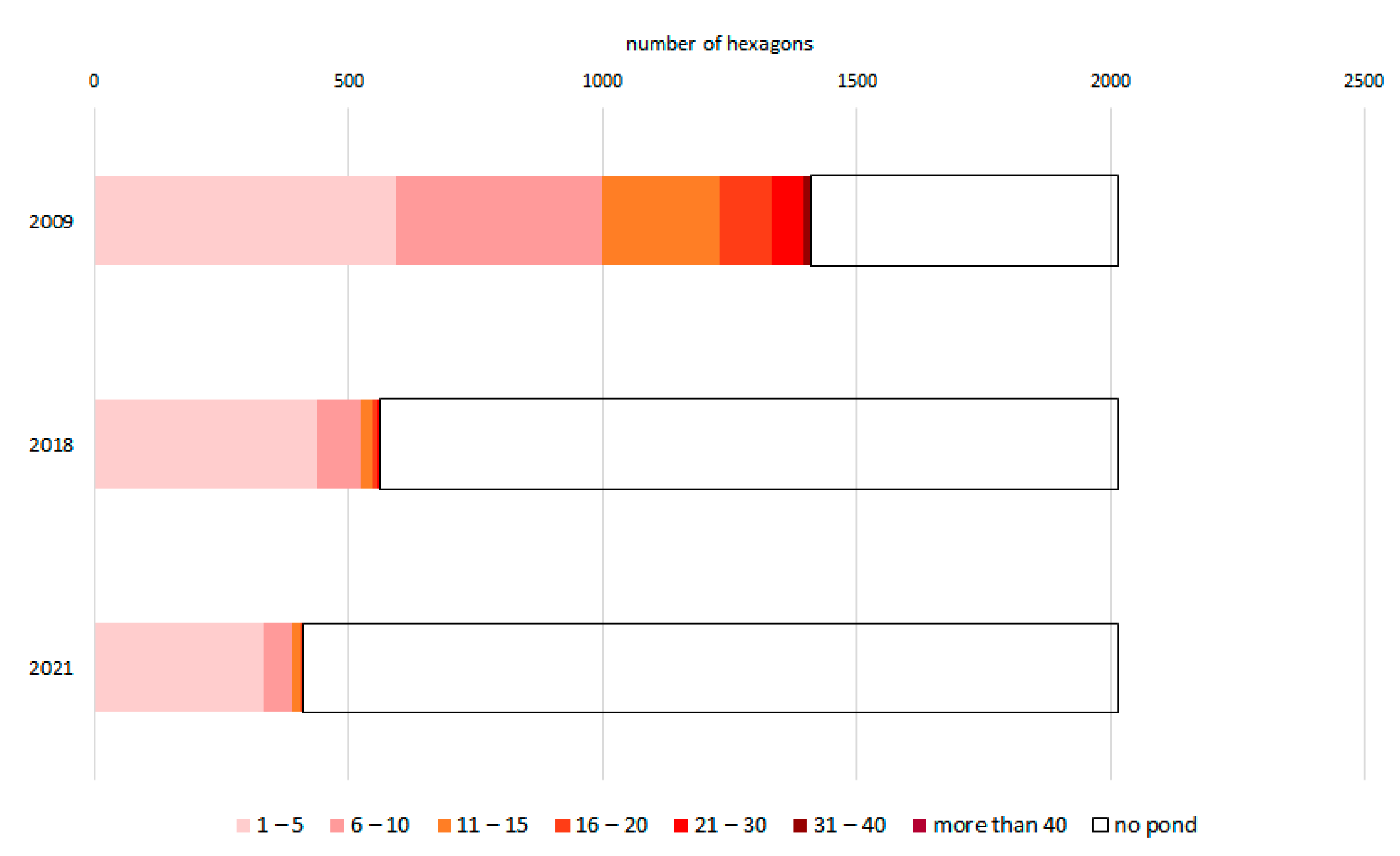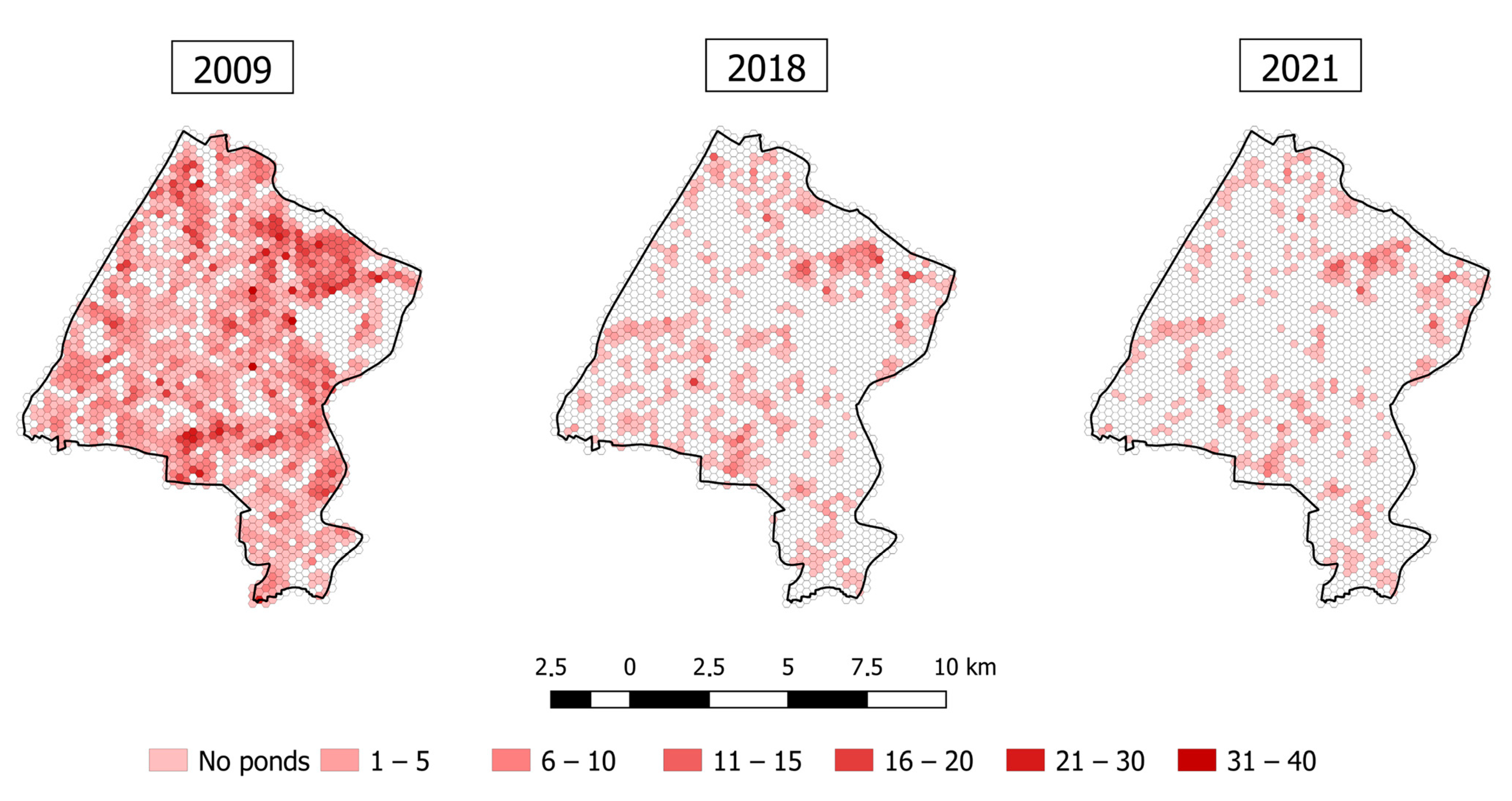1. Introduction
In the last three decades, agroforestry systems have largely been studied and promoted at the scientific and policy level, mainly due to their capacity of providing different ecosystem services to local communities around the world [
1,
2,
3] and as examples of adaptation to different and difficult environmental conditions, and therefore as best practices and strategies for adaptation and mitigation of climate change [
4,
5,
6]. Therefore, agroforestry systems represent a particularly topical issue, given the direct and indirect correlations between climate change and population health [
7,
8,
9]. Traditional agroforestry systems have been developed through the centuries by local farmers to obtain different products and services from the same plot, but in most cases scientific research focused on their structure or on the provided ecosystem services without sufficiently considering their origin, the reasons why they have been developed, and how they evolved through the centuries. Investigating the origin and the evolution of traditional agroforestry systems, and assessing the main features and threats, can contribute to identify strategies for their preservation and valorization, as well as highlighting the possibility of replication in similar environmental conditions for climate change adaptation and mitigation.
In some cases, agricultural and/or agroforestry systems have been developed as forms of adaptation to difficult environmental conditions, where other types of agricultural activities would not be possible. The excess of water can represent a major limitation for agriculture, and humans developed ingenious techniques for practicing agriculture on frequently flooded lands or even on the surface of lakes or wetlands through the construction of floating islands, as in the case of the Inle Lake in Myanmar, Tonle Sap lake in Cambodia, or in Bangladesh wetlands [
10,
11,
12,
13,
14]. In other cases, traditional agroforestry systems have been developed not as the main purpose, but as a consequence of the increase of land availability after reclamation and the implementation of flood control systems [
15,
16,
17]. The development of flood control systems through the creation of extensive systems of water channels has been historically crucial to protect cities and villages in frequently flooded areas. These flood control systems not only allowed living in places with recurring floods, but also created a system of water channels used as communication or transport network, and increased land availability for cultivations, therefore creating new opportunities for agriculture and agroforestry, and new landscapes. These new landscapes were also based on strong functional, cultural, and economic interactions between the water and the agricultural system. In addition, being often developed near cities and villages, these integrated systems of flood control and agriculture became crucial for providing fresh products to the inhabitants of the cities, and their role remained often unchanged for centuries. Nowadays, the traditional knowledge linked to these flood control systems and their capability in adapting to ecological, economic, and social pressures are widely recognized [
18]. At the same time, peri-urban traditional agricultural and agroforestry systems are considered a priority at an international level, as they serve as a link connecting cities and rural areas, providing local food and other ecosystem services, as well as representing important recreational areas for people living in the cities [
19,
20,
21]. This is particularly relevant considering that, at a global level, people are increasingly moving from rural areas towards big cities; this trend is also affecting and compromising peri-urban agricultural and agroforestry systems, which are threatened by urban sprawl, with a consequent reduction of agricultural and agroforestry surface and of the related functions and associated ecosystem services [
22,
23]. The preservation of traditional peri-urban agricultural and agroforestry systems developed as a consequence of flood control systems is particularly important, as their abandonment can have negative consequences not only on the cultural landscape and on the supply of local food but can also affect the effectiveness of the water drainage system and therefore their role in protecting the cities from floods, especially in a context of climate change and of intensification of rains. In fact, in the last decades, floods represent one of the most frequent and dangerous natural hazards at global level, mainly due to the increase in number and intensity of extreme rainfalls [
24,
25,
26].
One of these systems is the mulberry-dykes and fishponds system (MFS), located near Huzhou city, Zhejiang province, China. This system is based on fishponds and on small cultivations practiced on the earth dykes dividing the ponds, with particular attention to mulberry trees for silkworm production. This site is recognized at a global level for its sustainability and for the strong interlinkages between mulberry cultivation and fish raising, testified by its inclusion in 2017 into the Globally Important Agricultural Heritage Systems (GIAHS) Programme established by the Food and Agriculture Organization (FAO), whose aim is to identify and preserve agricultural systems of global importance with their landscapes, biodiversity and agro-biodiversity, traditional knowledge, and associated culture [
27,
28]. The choice of focusing this research on an area included in this program is due to the fact that that is the main world programme specifically dedicated to cultural landscapes and to traditional agricultural and agroforestry systems. Therefore, the inclusion in this programme certifies the global importance of the system itself. In fact, in this area, traditional activities carried out by generations of farmers created a sustainable agricultural heritage system, but also shaped the land to adapt to difficult environmental conditions (the excess of water and recurring floods), creating a unique cultural landscape.
This paper intends to reduce the knowledge gaps associated with ancient agroforestry systems developed as a consequence of reclamation for flood control in peri-urban areas, also considering that the protection and restoration of existing flood control systems is considered a key issue [
29,
30]. In addition, despite the fact that this system is considered by FAO of global importance, in the last few years rural areas close to major Chinese cities have been under big pressure due to urban sprawl as a consequence of internal migration from countryside towards big cities [
31]. In particular, the aims of the paper are: (i) to carry out a multitemporal analysis to measure land use changes in the last 12 years to evaluate the level of integrity and the main threats; (ii) to evaluate the effectiveness of the inclusion into the GIAHS Programme regarding land use changes and landscape transformation mitigation. The findings of this research could be used by local stakeholders and by the GIAHS Secretariat as a baseline for future monitoring, and also for improving their strategies and as a support of local and regional territorial planning.
4. Discussion
The results of our analyses demonstrate that MFS has undergone major land use changes in the last 12 years, and that the main causes are urban sprawl, spread of solar panels, and abandonment of the traditional mulberry-based systems in favor of modern fish-raising ponds. Traditional mulberry-fish pond system land use suffered a decrease of −2778 ha (−75%), while intensive fishponds increased by 2665 ha.
The first thing to be considered is that MFS GIAHS site is located near a major city, and is therefore suffering big pressure due to urban sprawl. According to Su et al. [
46]. Tiaoxi watershed experienced rapid socioeconomic development during the last 25 years, mainly as a consequence of population growth, which increased from 2.09 million to 19.32 million, with a net growth of 8.2%. This is also confirmed by our results, as in the last 12 years modern built-up areas have increased by +52%, while traditional villages decreased by −4.3%. The growth of new urban and industrial areas and of infrastructures caused higher levels of fragmentation and isolation of the agricultural patches, which became less abundant and connected and became more irregular and fragmented at a landscape level. Urban sprawl and the replacement of traditional villages with modern residential areas is not an uncontrolled process, and is mainly the consequence of a provincial policy whose aim is to promote the agglomeration of population, industries, and functions at a county and town level [
47].
Urban and industrial sprawl are not only causing problems for landscape connectivity and the preservation of the local agroforestry system, but are also responsible for water and air pollution. According to Xiao et al. [
48], water quality is highly dependent on the landscape characteristics, and their investigation carried out in Huzhou City proved that local land use change is responsible for the deterioration of river water quality, since landscape pattern controls various biogeochemical and physical processes, with the final consequence being that water pollution not only leads to an alteration of the river ecosystem, but also threatens public health and socio-economic sustainability. In addition, emissions can also affect the mulberry trees and the local silk industry, as the fluoride pollution in mulberry leaves negatively affects the yields of the silkworm cocoon [
49].
The other major threat regarding land use change, is due to the spread of photovoltaic systems, which reached a surface equal to 317 ha, with a +7% in the period 2018–2021. This trend is not surprising, even if it is deeply affecting the local landscape, since it is in line with national and regional trends. In 2019, China accounted for 32.6% of the world’s overall installed capacity of photovoltaic power, mainly thanks to regional and national policies carried out in the last decade. For example, Zhejiang province launched aggressive policies to support photovoltaic systems in the early 2010s, becoming the first province according to the cumulative installed capacity [
50]. Despite some policies being specifically aimed at placing solar panels on the rooftop of houses (as the Million Households Project), and therefore minimizing the impacts on productive surfaces, our study demonstrated that the spread of solar panels in the area mainly occurred on agricultural surfaces. The spread of solar panels, even if it is important for increasing the amount of clean energy, should be carefully evaluated, in particular within agricultural heritage systems, especially because of the negative consequences on landscape perception and on the aesthetic value of the traditional landscape. In this regard, results showed that photovoltaic systems are not small solar panels evenly distributed within the area but are big solar farms with an average size of about 17 ha, thus maximizing the impact on the local landscape from a perceptive point of view.
Other changes are instead related to the shape and size of traditional fishponds and on the abandonment of the practice of planting and managing mulberry trees on the dykes. According to the findings of our study, fishpond numbers decreased by −81% in the period 2009–2018 and by −33% in the period 2018–2021. At the same time, the irregular or oval shape of the traditional ponds is often replaced by square and bigger ponds, as reported by Ye et al. [
51], who found that the dyke–pond ratio changed from 6:4 to 3:7 or 2:8 in the last years. This is partly due to the strategy of “taking the road of agricultural modernization with Chinese characteristics”, which was firstly explicitly put forward at the 17th National Congress of the Chinese Communist Party in 2007 to increase agricultural production and ensure farmers’ incomes. As a result, China entered a period of increasing agricultural modernization aiming to narrow the gap between urban and rural areas. After that, in 2017 the “Rural Revitalization” strategy was proposed at the 19th National Congress of the Chinese Communist Party to better integrate agriculture, farmers, industry, and urban areas. At the local level, these policies have favoured the development of a modern aquaculture paying attention to environmental aspects, but not to traditional landscape and heritage [
52,
53].
In addition, due to industrialization of the silk production, traditional techniques that relied on manual skills are not applied anymore, and with the cessation of the use of stilt to fertilize mulberries, accumulated at the bottom of the ponds, the water level became shallow, and fish diseases increased. The inclusion in the GIAHS Programme brought some improvements at a management level, but did not solve the main vulnerabilities. After the recognition of MFS as GIAHS in 2017, dredging of the ponds has been organized [
54], even if with a reduced frequency compared with the twice a year dredging commonly practiced in ancient times. The use of mulberries planted among fishponds and the functional linkages and exchanges among trees and fishponds are common to various agroforestry systems in China [
55], but the decrease of the traditional and integrated system with mulberries and fishponds, with the replacement of modern fishponds, turns this system in an intensive fish-raising system, while the agroforestry component and the related benefits and services for the environment and the local population are disappearing. The progressive loss of traditional agroforestry systems, despite the recognized importance at the scientific level, is not only happening in China, but also in other countries and continents, as in Europe. The main cause is the spread of intensive agriculture, with the consequent reduction of the overall sustainability of the systems [
56,
57], of the related Ecosystem Services and biodiversity [
58,
59], and also of the energy efficiency and of the financial benefits to farmers [
60]. In this sense, the reduction of the surface devoted to the agroforestry system is particularly relevant considering recent research. Zhang and Liu [
61], who performed a study on the importance and sustainability of agroforestry based on 118 China National Important Agricultural Heritage Systems (China-NIAHS), found that agroforestry is strongly correlated with different sustainability indicators (including biodiversity, income diversity, resource utilization, hydrogeological preservation, water regulation). The same authors asked for promoting agroforestry in order to enhance the sustainability of agricultural productive systems. The assessment of the different Ecosystem Services related to agricultural heritage system, and of their economic value, could also represent an important indicator, even if it is not exempt from criticalities [
62]. Although the GDP per capita increased in Huzhou City in the period 1996–2001 from 15.03 thousand Yuan to 19.10 thousand Yuan, the total Ecosystem Services value decreased from 19.48 billion Yuan to 17.36 billion Yuan [
63]. Another problem is the lack of participation and awareness of farmers in relation to the GIAHS recognition and values. This problem is not only related to the MFS, but is also common to other Chinese GIAHS sites, as demonstrated by Siyuan et al. [
64], who found that being often a top-down initiative, farmers think that conservation is something that has to deal with the government and not with them, and therefore, GIAHS is not still perceived as an effective tool to encourage farmers to become active in conservation unless they do not receive economic benefits. In this regard, Siyuan et al. suggest that there is a need for turning non-economic values into economic values within agricultural heritage systems, i.e., providing farmers with conservation subsidies, as with the maintenance of their traditional activities they contribute to providing different Ecosystem Services to all the community. Xingguo et al. [
65] identified different vulnerabilities in the protection and planning of agricultural heritage systems in Zhejiang Province, including imperfect management of heritage sites, low participation of community residents, and lack of special protection funds. The same authors propose five different countermeasures. Among them, the improvement of the management structure and the development of a regional branding of agricultural products coming from GIAHS sites can have a potentially important role for the MFS. Rural tourism can instead be crucial for diversifying farmers’ incomes and can therefore entice farmers to maintain their traditional activities.
Expanding the discussion from the Chinese sites to the GIAHS Programme in general, it is important to remember that every GIAHS site represents a long history of development, trial and error, and innovation, as rural communities have adapted to changing conditions in both the human and ecological systems [
66]. Since socio-economic conditions are always changing, it is not possible to consider a GIAHS site as an immutable system only because it is included in the FAO Program. Therefore, since the GIAHS Programme has been established 20 years ago, it appears urgent to monitor the status of the inscribed sites, not only of the ones included in the Programme in the first years, but of all of them, as our study proved that even in a reduced time interval, major changes can occur. FAO has not yet set any standardized GIAHS monitoring, leaving it to the discretion of each GIAHS site to conduct voluntary self-evaluation. This is a major concern in relation to the future of the GIAHS Programme, and according to Jiao et al. [
67] there is the need to develop a scientific-based monitoring systems for GIAHS, not only to highlight the conservation needs or the threats, but to contribute to the sustainable development of the heritage site. Reyes et al. proposed a set of indicators to monitor GIAHS sites [
68], including “Land use/land cover change statistics” and “Policies and regulations related to agriculture”. The findings of our study highlight that monitoring landscape and land use changes is crucial to measure the effective level of conservation of the agricultural heritage system, to identify the main threats and the main trends, but can also be fundamental for evaluating the effectiveness and for addressing local and regional territorial planning and policies.
Local Territorial Planning and Projects
Failure to recognize the ecological and cultural value of MFS has resulted in early protection and utilization not being coordinated with other urban and rural planning, land use planning, and water conservancy planning. The main planning tools at a local level are summarized in
Table 7. Modern water conservancy projects, such as the construction of large reservoirs, Dongshaoxi Flood Control Project, Lou Gang Dredging Project, and the embankment reconstruction project, have been carried out one after another, contributing to solving the flood problem and providing security for agricultural production, and also introducing some criticalities. For example, the Dongshaoxi Flood Control Project focused on the water storage and irrigation of the western hills area, ignoring the irrigation demand of the eastern plain. Dongshaoxi has always been the main irrigation source of the eastern plain for ensuring high quality products, especially the fish raised in the MFS. Similarly, in the project of increasing the elevation of the dykes to improve flood control, the traditional use of silt to fertilize mulberry trees planted on the dykes was not considered, highlighting a severe lack of coordination between different local projects dealing with flood control and agricultural production. At the same time, past urban planning paid little attention to the process of protection of agricultural heritages, which was instead better considered in the newest urban plan (2017–2035) that proposed to build a network of blue–green public spaces based on a multi-tiered ecological pattern; this is the result of a better awareness regarding the urban water system, which is no longer only perceived as an important flood control system, but also as a public space. In fact, after becoming a Chinese National Important Agricultural Heritage System (NIAHS) in 2014, the multi-functional and multiple values of MFS started to be valued. The established MFS leading group, composed of various municipal departments (agriculture, development and reform, finance, water conservancy, culture, tourism, land, construction, environmental protection, and others), started to improve the organization and coordination among various departments [
69]. However, cooperation of professionals in specific planning group is not yet emphasized adequately.
The inclusion in the GIAHS Programme has instead highlighted the cultural heritage linked to the MFS, contributing to promote touristic activities based on its unique landscape, traditional knowledge, and culture [
70]. Rural tourism focused on the development of scenic spots, farmhouse accommodation, cultural and creative products, shops for ecological agricultural products, and outdoor entertainment activities. According to 2016 official data, the area received more than 1 million tourists, and the revenue of rural tourism was about 40 million yuan [
71]. The increasing touristic attractiveness, together with the GIAHS labelled products, the promotional activities the cultural festivals related to the MFS, the educational activities in primary and secondary schools, and training activities for farmers, all contribute to bring relatively high income to the local farmers and to support the active conservation of the traditional system, but also to the creation of new jobs opportunities at a local level [
70]. In addition, a special protection fund by means of government allocation has been set to provide subsidies and rewards to village groups that manage and restore traditional fishponds. However, local plans have eased the disappearance of mulberry ponds, but cannot avoid the overall trend of disappearance. The main problem seems to be that the economic benefits brought by this model (government subsidies, agricultural operations, rural tourism, etc.) to farmers are weaker than the economic benefits brought by agricultural modernization.
5. Conclusions
The mulberry-dykes and fishponds agroforestry system (MFS) is considered an agricultural heritage system of global importance by the FAO, and is an example of a traditional Chinese ancient agroforestry system developed through the centuries as a result of a flood control system to protect Huzhou city from recurring floods. The study demonstrated that this system is currently affected by several threats, in particular by urban sprawl (including the spread of photovoltaic systems) and agricultural intensification. The study also demonstrated that the inclusion in the GIAHS Programme was not sufficient to stop negative trends affecting the traditional system, but partly contributed to slow down these trends. In addition, after the GIAHS inscription, local planning tools started to progressively recognize the importance of the traditional MFS. The applied methodology proved to be effective in measuring land use changes, in identifying the main threats, and in characterizing the spatial pattern of the fishponds, providing a large amount of data that can be used to inform and address local planning as well as the GIAHS secretariat, and that can also represent a baseline for future monitoring. A limitation of the study is that it is restricted to the GIAHS site, while it would be interesting to check if the identified pressures and threats (urban sprawl, photovoltaic systems, agricultural intensification) are taking place with different intensity outside the GIAHS site borders. Another limitation is that the study focused on the landscape changes taking place only in the last 12 years, while it also would be interesting to analyze the previous situation; unfortunately, it was not possible to find high-quality aerophotos or satellite images prior to 2009.
On one side, MFS developed and evolved as a consequence of the past needs of the local populations, in particular as the result of a flood control system that protected Huzhou from floods, but also as the consequence of the local farmers’ needs to obtain agricultural products, first rice, then mulberry leaves for the local silk industry and fishes for human consumption. On the other side, these needs are still evolving and changing, and new expectations and services are demanded from rural areas, especially from peri-urban ones in a country where land use changes can take place very fast. Nowadays, the need of new residential areas for people moving from marginal areas towards the surrounding of big cities and the need of producing clean energy are contributing to deeply transform the local landscape structure, affecting the traditional agroforestry system. The consequence is that a system recently recognized of global importance by the FAO is currently facing major pressures and changes, with the possible consequence of its disappearance in the near future. In addition, it has to be considered that the importance of MFS is not only related to the cultural heritage or as an example of adaptation and mitigation, but also to its effectiveness in reducing flood risk. To protect and valorize this unique agroforestry system (but also similar ones), it would be necessary to develop adequate and specific planning instruments and policies at a local level that would consider the range of ecosystem services provided by MFS, and not only the economic value based on the final agricultural products. In this sense, the training of younger generations can be crucial for increasing the awareness of the role of this system for sustainable agriculture and flood risk mitigation; at the same time, rural tourism can contribute to provide additional incomes to local farmers. More generally, it is necessary to regularly monitor agricultural and agroforestry heritage systems, and in particular the ones inscribed in the GIAHS Programme as they are considered of global importance by the FAO, but also the cultural landscapes included in the UNESCO World Heritage List, with a standard methodology and measurable indicators, to provide data for informing planners, therefore contributing to their preservation for future generations. In this sense, it is important to recognize the multiple values and ecosystem services related to MFS, in particular by the local stakeholders, that directly or indirectly affect the site through their strategies and actions. Therefore, a closer communication and cooperation among various stakeholders is required to better coordinate their aims. On the other side, it is important to strengthen farmers’ identification in ecological, economic, and cultural aspects, and to promote their active participation and involvement in local planning, especially as farmers are the main actors, bearers, and disseminators of knowledge, culture, and values.


